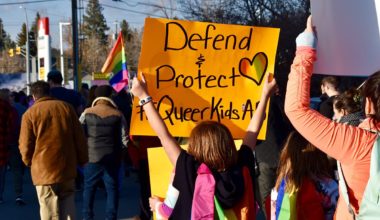Updated 03/21/24
Discussions about sexual orientation are often focused on sexual attraction toward a specific gender. However, some people feel little to no sexual attraction to anyone, regardless of the type of gender. This is where the discussion of the asexuality (which is its own sexual orientation) spectrum begins.
While approximately 1% of the population identifies as asexual (or as “an ace”), it’s likely that many more people have similar thoughts and feelings. It’s important to note that asexuality isn’t the same thing as abstinence or celibacy, where a conscious decision is at play. So, what does it mean to be asexual? It’s feeling no (or very little) sexual arousal or attraction to anyone at all, even if someone is or has been sexually active in the past.
If you don’t feel sexually attracted to others, you’re not alone. There’s a lot to understand about what the asexuality spectrum really means, and we’re breaking it all down here.
Defining the Asexuality Spectrum
Understanding the asexuality spectrum is crucial in recognizing the diverse experiences within the Ace (asexual) community. This spectrum encompasses various identities, including the three most commonly identified subsections: asexual, demisexual, and gray asexual.
Not everyone on the asexuality spectrum will have the same sexual intimacy, feelings, or experiences. Just because an ace person isn’t sexually attracted to a specific gender doesn’t mean they don’t have the same wants, needs, or desires as everyone else.
Asexuality itself is simply the absence of sexual attraction towards others, serving as a baseline within the spectrum. Demisexual individuals experience sexual attraction only after forming a deep emotional connection, whereas gray asexual (gray-A) people might only occasionally feel sexual attraction or do so under specific circumstances. Collectively, these identities highlight the spectrum’s complexity and the importance of acknowledging each person’s unique experience with sexual attraction.
Types of Asexuality
Sexual orientation describes how you experience sexual attraction. It specifically refers to feelings of sexual desire. While asexuality is a sexual orientation, different types of asexuals experience it in different ways. Asexuality is a spectrum, and there are several different types of asexual people.
People in the ace community may fall anywhere on this asexual spectrum:
Asexual
As discussed, the term asexual describes the sexual identity of someone who doesn’t experience sexual attraction to others. Some people who are asexual may still experience sexual desire, while others may not have any sexual feelings at all.
Greysexual
Sometimes referred to as “gray aces” or “gray-a,” people who are greysexual are primarily asexual. However, these members of the asexual community may enjoy sexual behavior under very specific circumstances, or they might experience sexual interest on rare occasions.
Demisexual
People who identify as demisexual will only feel sexual attraction once they have a strong emotional connection to someone else. Although people who are demisexual are on the asexual spectrum, they’re more likely to engage in sex than people who are asexual or greysexual.
“Asexuality is different from abstinence, where someone chooses to not have sexual contact regardless of their sexual urges. Someone with an asexual identity is not necessarily someone who has never engaged in sex. Asexual individuals don’t feel sexual attraction towards people of any gender and it is also considered a type of sexual orientation. It is important to clarify that asexuality is not a medical or mental condition or diagnosis. It is a sexual orientation in the same way that homosexuality, bisexuality, and pansexuality are.”
– Talkspace therapist Bisma Anwar, LMHC
Understanding the Diverse Attitudes Toward Sex
Within the asexuality spectrum, individuals’ attitudes towards sex vary significantly, reflecting the complexity of their experiences and feelings about sexual activity. These attitudes range from sex-negative to sex-neutral, and even to sex-positive, each offering a unique perspective on how asexual (or Ace-spectrum) individuals engage with the concept of sexuality.
Sex-negative
For a sex-negative asexual person, sex seems unpalatable or even disgusting. While asexuals who are sex-repulsed might not believe sexual activity is morally wrong, they do find it to be extremely unpleasant.
Sex-neutral
A sex-neutral asexual individual can feel indifferent to sexual activity. They don’t have any strong positive or negative feelings about sex, and may not think about it much at all.
Sex-positive
While sex-positive aces don’t experience sexual attraction, the feelings they have about sex and sexual things are generally favorable. They may see sex as a normal, healthy part of life. Some sex-positive asexuals may even choose to have a sexual relationship.
Romantic Orientation
While asexuals might not experience primary sexual attraction, they may still have romantic connections with others. In fact, approximately 74% of asexuals say they experience romantic attraction. The asexuality spectrum is broad, and feelings about sex, romantic orientation, and romance can vary greatly from person to person.
Aromantic
Sometimes referred to as “aroaces” or just “aro,” aromantic describes those who don’t have any (or very little) feelings of romantic attraction. An aromantic asexual is more likely to avoid sex than some other asexual types. An aromantic person simply may not feel any need to connect on that level, either physically or emotionally.
Greyromantic
As the name implies, greyromantic asexuality falls into a grey area. While they don’t usually feel any sort of romantic interest, someone who’s greyromantic may have romantic feelings for another person at some point in their lives.
Demiromantic
People who are demiromantic can have romantic feelings towards others, but they’re not able to develop them until after they’ve become very close to someone. Some people who identify as demisexual also identify as demiromantic.
Biromantic
When people are bisexual, they experience sexual attraction to both males and females. Being biromantic is similar, but it refers to romantic feelings.
Heteroromantic
When someone only has romantic feelings for people of the opposite gender, heteroromantic attraction and heterosexuality often go hand in hand. However, people who are asexual may also identify as heteroromantic.
Homoromantic
Someone who’s homoromantic exclusively feels romantic desire for people of the same gender. Asexuals of any gender can experience homoromantic attraction.
Panromantic
Someone who is panromantic has romantic, emotional feelings and connections to all people, regardless of gender. For panromantic people, gender has no influence over romantic attraction.
Polyromantic
While there are similarities between polyromantic and panromantic attraction, people who are polyromantic can have a romantic attraction to many (though not necessarily all) genders. Their attraction doesn’t always include sexual attraction, though.
Asexuality vs. Sexual Arousal Disorder
Asexuality can often be misunderstood as sexual interest/arousal disorder. The difference between the two is that asexuality is the lack of sexual attraction, and sexual interest/arousal disorder is the lack of sexual desire.
The Bottom Line
When discussing asexuality, it’s important to remember that not all asexual people have the same experiences with sex and romance. Some may choose to have sex even though they don’t feel sexual attraction. Others may have no interest in sex or any romantic relationship at all.
There are many asexual types, and not everyone who identifies as asexual experiences their sexuality in the same way.
People who feel little to no sexual attraction don’t have to follow any specific rules or meet any specific criteria about the emotional, sexual, or spiritual connections and relationships they have in life. Asexuality is both a spectrum and a sexual orientation and identifying as asexual may help some people form a healthier view of themselves.
Asexuality is not a condition, and there’s no “treatment” you need if you’re questioning your sexuality or how you identify. However, heteronormative views are common in the United States. They can be a contributing factor to the discrimination and abuse felt by so many people who don’t express “traditional” (as established by our society) sexual orientation, sexual identity, and/or gender roles.
“Asexuality is not something that needs treatment or intervention. If a person is looking for support and affirmation in regards to their sexuality and/or sexual orientation, then therapy can be really helpful.”
– Talkspace therapist Bisma Anwar, LMHC
For anyone who doesn’t align with society’s expectations of things like gender identity and sexual orientation, the rates of mental health conditions like anxiety, depression, and self-harm are staggering. Specifically regarding ace-spectrum people, the little research that has been done shows that ace-spectrum youth are likely to experience higher rates of anxiety and depression than even the LGBTQIA+ community (which is already drastically higher than the cisgender population).
If you’re sexuality or gender questioning and you need help, it’s available. Talkspace offers online therapy and has therapists who are skilled, trained, and experienced in affirmative therapy, which was designed specifically to treat the mental health needs of minority populations. Find a LGBTQIA+ therapist today.
Sources:
1. Bogaert A. Asexuality: Prevalence and associated factors in a national probability sample. The Journal of Sex Research. 2004;41(3):279-287. doi:10.1080/00224490409552235. https://pubmed.ncbi.nlm.nih.gov/15497056/. Accessed June 9, 2022.
2. Yule M, Brotto L, Gorzalka B. Sexual Fantasy and Masturbation Among Asexual Individuals: An In-Depth Exploration. Arch Sex Behav. 2016;46(1):311-328. doi:10.1007/s10508-016-0870-8. https://link.springer.com/article/10.1007/s10508-016-0870-8. Accessed June 9, 2022.
3. Copulsky D, Hammack P. Asexuality, Graysexuality, and Demisexuality: Distinctions in Desire, Behavior, and Identity. The Journal of Sex Research. 2021:1-10. doi:10.1080/00224499.2021.2012113. https://www.tandfonline.com/doi/abs/10.1080/00224499.2021.2012113?journalCode=hjsr20. Accessed June 9, 2022.
4. Antonsen A, Zdaniuk B, Yule M, Brotto L. Ace and Aro: Understanding Differences in Romantic Attractions Among Persons Identifying as Asexual. Arch Sex Behav. 2020;49(5):1615-1630. doi:10.1007/s10508-019-01600-1. https://pubmed.ncbi.nlm.nih.gov/32095971. Accessed June 9, 2022.
5. Asexual and Ace Spectrum Youth. The Trevor Project. https://www.thetrevorproject.org/research-briefs/asexual-and-ace-spectrum-youth/. Published 2020. Accessed June 9, 2022.
Talkspace articles are written by experienced mental health-wellness contributors; they are grounded in scientific research and evidence-based practices. Articles are extensively reviewed by our team of clinical experts (therapists and psychiatrists of various specialties) to ensure content is accurate and on par with current industry standards.
Our goal at Talkspace is to provide the most up-to-date, valuable, and objective information on mental health-related topics in order to help readers make informed decisions.
Articles contain trusted third-party sources that are either directly linked to in the text or listed at the bottom to take readers directly to the source.




